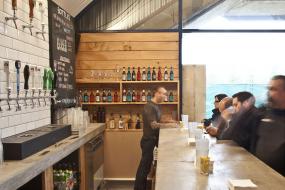 Not since the 1930s has London played host to nearly 50 brewing companies, with the capital being at the centre of a national resurgence in brewing beer and ale.
Not since the 1930s has London played host to nearly 50 brewing companies, with the capital being at the centre of a national resurgence in brewing beer and ale.
Back in 2001, you could only find 10 breweries situated in the capital. But with an increase to 48, in comparison to the all too regular sight of a boarded-up pub, the big question is whether it is a profitable and sustainable market.
Young & Co’s Brewery, one of the biggest in the capital, doesn’t believe it is a sustainable market, moving away from brewing after selling its 40 per cent share in Wells and Young’s Brewery in August 2011 to focus on its pubs.
However, according to the 2013-4 Cask Ale Report, 58 per cent of cask ale drinkers started drinking ale under the age of 25, and 20 per cent of drinkers tried ale for the first time in the past four years.
Cask-ale ferments with the grain – as it sits in the barrel, the ale is like a living beer, gaining maturity and flavour.
There are a number of reasons for the increasing number of people, especially young people, drinking ale and fuelling the boom in breweries. Previously, London was seen as too expensive for small breweries, whilst other breweries stayed away from the capital due to the quality of the city’s water.
Now, small breweries are tripping over themselves to grab a foothold on the London market. Each brewery is trying to create its own unique selling point by experimenting with the taste of their ale, leading to many weird and wonderful creations.
Farouk Kahlib, deputy brewer of West London’s Portobello Brewery, said: “The young early-twenties generation has changed the market; they come to the brewery and love it, always looking for new tastes.”
Portobello Brewery is one of the standard bearers of the new small breweries and micro-breweries offering craft ale opening up in London. Since launching in 2011 with support from drinks distributor Hills Prospect, Portobello are now producing 150 casks a week across a range of six beers, from lager to ale and porter.
Portobello pride themselves on using well-sourced traditional British hops as well as doing everything by hand to produce a better quality to their craft ale. This is set to continue when they move to a larger site, planned for early next year. At the moment everything is restricted, with the brewery operating with a staff of only six, two of whom are full-time.
Farouk Kahlib added: “Similar to food, people want something different and will explore their options. The most important thing is that you have a good product, and then it is easy to sell.”
London has become a hub of brewing. Truman’s Beer, revived in Leicester in 2010, moved production to Hackney Wick in August 2013. With a lot of young professionals in the city, breweries are keen to grasp the large London market as much as possible.
This growing market also includes an increasing number of women. According to the 2013-4 Cask Ale Report, 34 per cent of women have tried ale and nearly all would drink it again.
Women offer a whole new dynamic to a market that has previously been seen as the preserve of older men. Many London breweries are following in the footsteps of breweries such as Warwickshire’s Purity Brewing Company, who have created a dynamic contemporary brand. They target young drinkers with regard to the flavour of their drink, design of the product and in their promotional style. Purity is one of the quickest growing breweries nationwide, with growth as high as 53 per cent in 2011.
Owner Paul Halsey was mystified at why real ale was targeted at middle-aged men with themes of tradition and heritage, saying: “It’s been important that we make ale cool.”
CAMRA, the Campaign for Real Ale, has a membership of over 156,000 nationwide and is the largest single issue consumer group in the UK. However, criticism has been directed at them about a lack of support for the changing demographics of your average ale drinker by still targeting middle-aged men.
David Turner, a keen drinker and CAMRA member from South West London, said: “If I went to real ale festivals 10 years ago I would barely see a woman there. Now it is a much more common sight.”
The current growth in cask ale is coming from younger drinkers, mostly young professionals, the same demographic who more likely to be living with their parents than previous generations. With it being harder to get onto the property ladder, they have a larger disposable income that can be spent on ale.
John Cryne, CAMRA’s London regional director, said: “The change in lifestyle for a young professional is definitely a factor, but there is no one reason. Generally young people have to be interested in ale, they have to afford it and have the time to go down to their local pub.
“What we have seen are more interesting breweries and licensees. Since entrepreneurs such as Duncan Sanbrooke of Sanbrooke’s Brewery showed that small breweries in London were viable, the number has steadily grown.”
Government legislation this side of the millennium has been helpful to the cause of small breweries: since 2002, tax breaks have been given to micro-breweries, whilst duty on beer has been frozen since the 2013 Budget, and the tax on a pint lowered by 1p. This was after a heavy campaign by CAMRA to scrap the beer duty escalator, which previously rose two per cent above inflation annually.
However, many believe that more can be done, especially in the pubs’ fight against cheap supermarket beer. Larger breweries see it as unconducive that independent pubs, or free houses, get a business tax relief, often complaining that they are comparatively ‘poorly run’.
This hasn’t stopped Young & Co’s, who have looked to redefine the pub experience, focusing on managed pubs rather than the traditional landlord-run or ‘tenanted’ pub. This plan seems to be working well, with Young & Co’s closing 2013 stock showing a 40 per cent gain, double that of nearest rival Fuller Smith & Turner.
Stephen Goodyear, Young & Co’s CEO, said: “Our managed estate, which accounts for over 90 percent of group turnover, is the main driver of our growth and we don’t see that trend reversing.”
Style and presentation of a pub can also be key: the Wheatsheaf at Borough Market plays hip music, with a welcoming garden where customers can smoke. Customers can also buy drinks from a VW van and order mussels.
It is not always clear whether running a small brewery is truly profitable. The London Brewing Company produces 10 kegs a week for Highgate pub The Bull and is looking to expand. However, assistant manager Mark Packer admitted that they were just “breaking even”.
A big issue to the sustainability of these new breweries is that they rely heavily on pubs, which are slowly disappearing, with 54 per cent of people now drinking at home. Surely they cannot continue to grow unless they can tap into this growing market and sell their ale in bottles at large supermarkets.
Image courtesy of REX Features




